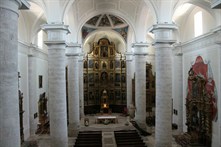The Cathedral of Getafe
Was the ancient church of Santa María Magdalena (Saint Mary Magdalene), but in 1991 it was elevated to the status of a cathedral and seat of the diocese of Getafe (Madrid).
 The construction work began in 1549 on the site of an ancient MudéjarMudéjar art became widespread in the Iberian peninsula after the end of Muslim rule in al-Andalus. It consisted in the incorporation of elements of Arabian-inspired style in the new Christian. The most famous example of Mudéjar art is the Alcázar of Seville. church of the fourteenth century, demolished due to its modest size after the increase in the population of the area. The new church was completed in 1770, built upon the orders of the Archbishop of Toledo, Juan Martínez Silíceo, and based on the design of the architect Alonso de CovarrubiasAlonso de Covarrubias (1488-1570) was one of Spain’s most important architects of the sixteenth century. He worked in the new cathedral of Salamanca and the chapel of the Reyes Nuevos of the Cathedral of Toledo. He was responsible for the construction of most of the great buildings of Toledo since 1534 when he was appointed Maestro de Obras of the cathedral and the diocese.. A century later, to avoid the collapse of the whole structure, the intervention of Juan Gómez de Mora, Philip IV‘s arquitecto mayor, was needed, who in 1622 decided to demolish the entire complex with the exception of the tower, cross vault and apse. The work continued until 1770, when the new façade was completed. At the beginning of the twenty-first century a major restoration of the entire building began, now defined as a Monumento Histórico Artístico (photo 1).
The construction work began in 1549 on the site of an ancient MudéjarMudéjar art became widespread in the Iberian peninsula after the end of Muslim rule in al-Andalus. It consisted in the incorporation of elements of Arabian-inspired style in the new Christian. The most famous example of Mudéjar art is the Alcázar of Seville. church of the fourteenth century, demolished due to its modest size after the increase in the population of the area. The new church was completed in 1770, built upon the orders of the Archbishop of Toledo, Juan Martínez Silíceo, and based on the design of the architect Alonso de CovarrubiasAlonso de Covarrubias (1488-1570) was one of Spain’s most important architects of the sixteenth century. He worked in the new cathedral of Salamanca and the chapel of the Reyes Nuevos of the Cathedral of Toledo. He was responsible for the construction of most of the great buildings of Toledo since 1534 when he was appointed Maestro de Obras of the cathedral and the diocese.. A century later, to avoid the collapse of the whole structure, the intervention of Juan Gómez de Mora, Philip IV‘s arquitecto mayor, was needed, who in 1622 decided to demolish the entire complex with the exception of the tower, cross vault and apse. The work continued until 1770, when the new façade was completed. At the beginning of the twenty-first century a major restoration of the entire building began, now defined as a Monumento Histórico Artístico (photo 1).
 Outside stands the brick tower with a square base that has the classic style of the era Madrid of the Habsburgs, with slate capitals. But it is inside where the Baroque style stands out. The three naves are separated by large columns supporting round arches; the central nave, as designed by Juan Gómez de Mora, with pavilion vaults, while the aisles have vaulted ceilings. Above the cross vault there is a big cupula decorated with frescoes of the eighteenth century (photo 2). The Retablo Mayor of the cathedral, built in Baroque style during the years 1612-1618 according to the project of Alonso Carbonel is also striking. It is built of polychrome and gilded wood and consists of niches that hold paintings and Baroque sculptures. The paintings of religious themes date back to the mid-seventeenth century, while the sculptures are worthy of note, especially one that depicts Santa María Magdalena (Saint Mary Magdalene), located in the center of the altarpiece. In the aisles there are other retablos in Baroque style, all of great artistic value.
Outside stands the brick tower with a square base that has the classic style of the era Madrid of the Habsburgs, with slate capitals. But it is inside where the Baroque style stands out. The three naves are separated by large columns supporting round arches; the central nave, as designed by Juan Gómez de Mora, with pavilion vaults, while the aisles have vaulted ceilings. Above the cross vault there is a big cupula decorated with frescoes of the eighteenth century (photo 2). The Retablo Mayor of the cathedral, built in Baroque style during the years 1612-1618 according to the project of Alonso Carbonel is also striking. It is built of polychrome and gilded wood and consists of niches that hold paintings and Baroque sculptures. The paintings of religious themes date back to the mid-seventeenth century, while the sculptures are worthy of note, especially one that depicts Santa María Magdalena (Saint Mary Magdalene), located in the center of the altarpiece. In the aisles there are other retablos in Baroque style, all of great artistic value.
